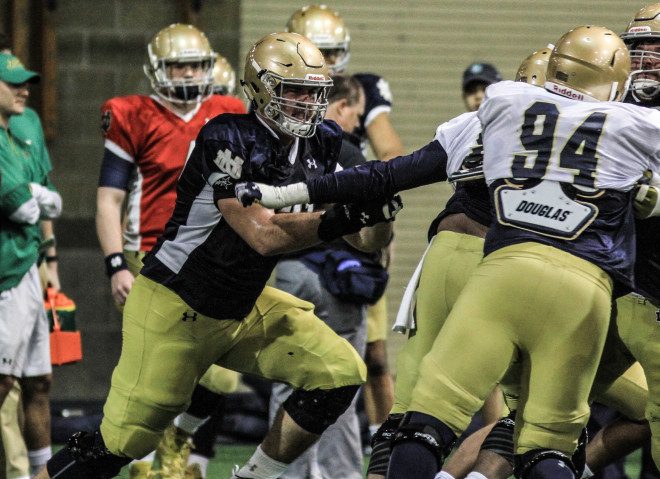Alex Bars Finding His Home At Right Tackle For Notre Dame Line

Although he will be entering only his junior season at Notre Dame with three more years of eligibility remaining, Alex Bars already has been a football nomad for Fighting Irish offensive line coach Harry Hiestand.
Bars enrolled as a prospective left tackle in 2014, and his combination of footwork, fluidity and power prompted head coach Brian Kelly to refer to him as one of the best offensive line prospects he’s seen in his 25 years of coaching. He also wanted to give him a chance to win the vacated left guard spot in 2015, where Bars battled five-star classmate Quenton Nelson. Bars didn’t get the nod while adjusting to his new role, but he did finish the game at Clemson on Oct. 3, when Nelson was injured, and started against Navy and USC the next two weeks.
Then against the Trojans, a fractured left ankle that he hoped would only be a sprain sidelined him for the balance of the season, and put him in a walking boot for eight to 10 weeks while not allowing him to put any weight on the ankle.
“I was dying to take off the boot," said Bars last week. "They’ve taken me slowly and made sure I’ve been able to do everything that they ask.”
Cleared to play this spring, Bars was then tabbed this spring to replace right guard Steve Elmer, who opted to graduate early and not return for his senior year in 2016 after having started all 26 games the past two years. However, with the need to replace three starters along the line, Hiestand’s main priority was to work from the outside in, meaning he wanted to first get the two tackle positions solidified.
The first move was to shift 2015 starting right tackle Mike McGlinchey to the left side to replace projected first-round pick Ronnie Stanley. That way, the team’s two best linemen, McGlinchey and Nelson, could work as a tandem.
Halfway into spring drills, Hiestand also decided that Bars would be more suited to tackle, where he was originally recruited, than senior Hunter Bivin, who Hiestand says “there are things he’s more comfortable doing in close quarters” as opposed to playing more in space at tackle.
“You have to have enough tackles,” Hiestand said. “[When] the game’s on the line, you have to protect the edge to have a chance to win the game. If you can’t do that, that’s going to be a problem.”
Bars so far in his Notre Dame career has lined up everywhere but center — and maintains he has no preference on where he plays — but he believes it has helped him get a better understanding of collective assignments up front.
“It’s been great,” Bars said. “Understanding defenses has been huge.”
When asked if Bars will stay at right tackle, Hiestand didn’t hesitate in his reply.
“For what we need for our team, definitely,” Hiestand said. “He needs to play tackle. We need another guy to play tackle. … He’s a very good guard too, a very flexible guy.
“We have to have guys that can protect on the edge at tackle when the game comes down to that. Many guys can do it on first and second downs. On third downs, obvious pass situations, you have to have enough range to cover that edge. … Alex has to be able to do that for us.”
The 6-6, 320-pound Bars was measured as the second-tallest player on the roster, behind 6-7 ½ McGlinchey, so his settling in at right tackle with his range is understandable. Still, it’s been an adjustment this spring both physically and mentally.
“It took a little while to get running again and get used to the workload,” admitted Bars about coming off his injury. “You have to be able to recognize different looks, something you don’t have to do at guard.”
“It’s been a process to get Alex back off that broken ankle,” Hiestand said. “We’re kind of progressing in and not overloading him too soon. He’s made great progress.”
Kelly described moving Bars back out to tackle a “significant” adjustment.
“Especially when he's going against Isaac Rochell and some guys that are big and physical and fast,” Kelly said. “He's one-on-one a lot more. Inside [at guard], you're in so many more combination scenarios where you have some help. You're on an island a lot more out there.
“I think he's starting to sense and feel how much of that falls on his shoulders. Getting adjusted to that and being technically sound in everything he has to do on a play-to-play basis is a lot for a young player.”
Kelly does not question Bars’ physical skills to handle the role eventually, and getting the playing time he did last year also was valuable.
“It helped him confidence wise,” said Kelly of Bars’ two starts at guard. “He's got confidence in his ability to go out and compete against anybody. Now it's handling that position, which is a different [role] for him.”
The left side of the line is expected to rank among the best nationally, but the right side is deemed, at least on the outside, as the top question mark on offense.
“It’s not a concern with me,” Bars said. “Coach Hiestand will figure it out.”
Lowering the Bars is not an option for the offensive line.